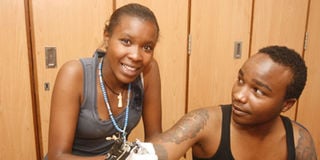Tattoos now all the rage among young Kenyans

Sonsley Noni makes the best of her artistic side by making art on others' skin. You may not see it, but she has a tatoo all across her back PHOTO/CHARLES KAMAU
What you need to know:
- Both men and women are fixated with the idea of self-expression through layers of ink
They are walking pieces of art. Bodies covered in drawings, young men and women all over the world are today fixated with the idea of self-expression through a form of art known as tattooing.
The art form has caught on in Kenya, with several tattoo parlours springing up in the country. Anthony Jones “Buju” is one such artist. He is based at Buju Sanii Art Studio in Thika town.
“Though tattoos can be drawn on virtually any part of the body, most clients prefer the upper arm,” says Buju. Other common areas are the chest, back and neck.
People ask for various types including tribal markings, 3D, religious wording, Polynesian/Maori, oriental and fantasy tattoos, he says. Dragons and koi fish are examples of oriental tattoos.
So, why do people choose to be tattooed? “Some people are tattooed to remember events in their lives; others get them to remember loved ones while others do it for fun,” says Isaac Yienya, a tattooist at Wayside Body Adornment Tattoos and Piercings at Kenya Cinema in Nairobi.
For many years, tattoos were the preserve of sailors, criminal gangs and bikers, but not any more. Nowadays, any adult can walk into a tattoo parlour and get any drawing he wishes.
Though the process is simple, caution must be taken. If one has a medical condition such as diabetes, heart disease or allergies, a visit to the doctor first is advisable.
Buju’s assistant, Ann, explains the procedure: “First, the image is printed or drawn on paper. Later, it is placed above spirit paper and after the client’s skin is cleaned with surgical spirit, the paper is placed on the area to be tattooed. The image appears on the skin in a bluish colour and the artist is then able to make the drawing.”
Clients are advised to avoid submerging the tattoo in water for 10 days, though a shower is fine.
The cost of tattoos depends on size and complexity. They can cost anything from Sh2,500 to Sh100,000.
Buju and Isaac are strict on age restrictions and do not tattoo anyone below 18 unless accompanied by a parent or guardian.
Buju says most children he tattooed are from the Asian community and are always accompanied by their parents. His youngest client was 14.
As different as the tattoos are in design, so are their meaning. The koi fish, for example, symbolises strength, wealth and prosperity. Snakes and skulls are the subject of controversy.
Due to varied perceptions, most Kenyans, particularly older ones, discourage tattooing. Nineteen-year-old Danielson, for instance, successfully hid his tattoo for a long time but his luck ran out when his father spotted it as he emerged from the shower.
“He was mad and wanted to know who had permitted me,” he says.
Religious beliefs also come into play. Sheila, a 12-year-old Christian, believes in the Bible verse: “You shall not make any cuttings in your flesh on account of the dead or tattoo any marks upon you: I am the Lord” (Leviticus 19:28).
Prof Karega Munene, an anthropologist and lecturer at United States International University, sees tattoos as “body art that has the ability to communicate.” He says they are just like clothes and can communicate rebellion, power and one’s way of life.
Removing a tattoo can be difficult, depending on its age, size as well as the types and colour of ink. Laser removal is the preferred method, but can last months and costs much more than the tattoo.
It is thus advisable that one thinks hard before getting a tattoo on a specific body part.




